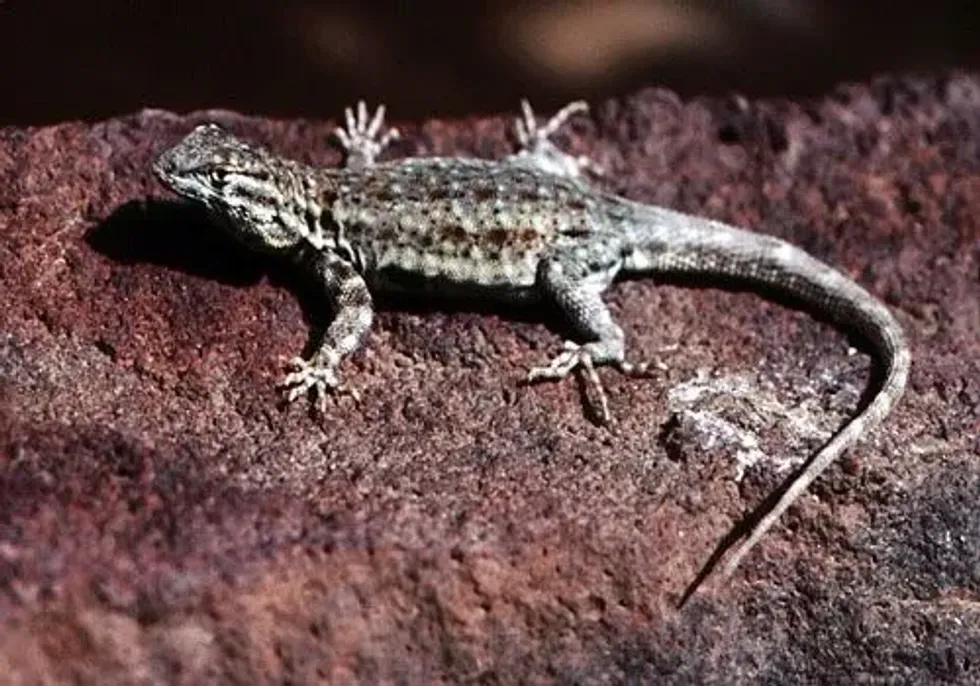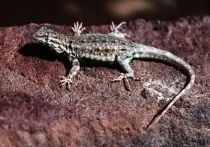Spotting creepy, crawling creatures, chilling on our walls can be quite scary! These tailed, quadrupedal beings, also commonly known as lizards, proudly wander around our houses uninvited.
These reserved animals, even though scary in appearance, are vital for certain trophic levels in nature. This fact file is about the reptile, sagebrush lizard (sceloporus graciosus).
These lizards are close relatives of reptiles like iguanas and chameleons. Another relative of the sagebrush lizard is a Western Fence Lizard. The sagebrush lizard (Sceloporus graciosus) belongs to the family Phrynosomatidae, hence is categorized as a western reptile and amphibian by the U.S.
Fish and Wildlife Service. The scales on their skin and darker brown blotches at the base of the tail give it a menacing appearance.
The natural habitat of these spiny lizards is spread across the US in states like New Mexico, North Dakota, Idaho, Arizona, Nevada, Wyoming, California, and Washington.
Here are some of the most interesting facts about the southern sagebrush lizard, afterwards do read our other articles on monitor lizard facts and frilled lizard facts.
Sagebrush Lizard Interesting Facts
What type of animal is a sagebrush Lizard?
The sagebrush lizard (Sceloporus graciosus) is a lizard that has been categorized as one of the western reptiles and amphibians by the U.S. Fish and Wildlife Service. The common sagebrush lizard (Sceloporus graciosus) is a quadrupedal reptile, with dark features and skin that makes it look like a small snake peeking from far!
What class of animal does a sagebrush lizard belong to?
Sceloporus Graciosus (common sagebrush lizard) is a chordate that belongs to the class of amphibians and reptiles in the kingdom Animalia. More specifically, they are members of the Phrynosomatidae family of the order Squamata.
The Sagebrush lizard (Sceloporus graciosus) is known to have a scaly exoskeleton, dark skin color, and big drowsy-appearing eyelids. The Phrynosomatidae family is formed of nine genera of lizards similar in features to a common sagebrush lizard.
How many sagebrush lizards are there in the world?
The common sagebrush lizard (Sceloporus graciosus) species can be found in abundance in their natural habitat roaming around on rock outcrops. Their population distribution range is considered stable; perhaps a little in decline number, owing to a variety of reasons, including loss of habitat.
According to the 2016 count of amphibians and reptiles by the U.S.
Fish and Wildlife Service, the population of common sagebrush lizard is estimated to be more than 100,000 in number across its natural habitat in New Mexico, North Dakota, Idaho, Arizona, Nevada, Wyoming, California, and Washington. The trends in sagebrush lizard population count vary accordingly, but at large sagebrush lizards are considered stable in number.
Where does a sagebrush lizard live?
The common sagebrush lizard species has been categorized as amphibians and reptiles by the U.S. Fish and Wildlife Service, much like the common side-blotched lizard (Sceloporus occidentalis).
This lizard is native to the North American states of New Mexico, North Dakota, Idaho, Arizona, Nevada, Wyoming, California, and Washington.
Here, it is found in a variety of habitats in many states, more commonly dwelling around the sagebrush shrub in arid and semi-arid regions. In America, one can find these lizards in many states such as Oregon, Montana, Washington, New Mexico, and Arizona to name a few.
What is a sagebrush lizard's habitat?
Northern sagebrush lizard (Sceloporus graciosus) wanders around sagebrush shrubs. It is mostly spotted in elevated regions, in rocky areas, and is seen resting on wood logs. It is also capable of burrowing in the ground and is capable of climbing on trees in case it is followed by a predator.
Who do sagebrush lizards live with?
Most of these lizards are not very social but may be seen living in small family groups. A dune sagebrush lizard may be spotted as a loner, wandering around in solitary, or like other reptiles, sagebrush lizards may also be spotted in small groups. During mating season, this species may be spotted in pairs.
How long does a sagebrush lizard live?
These lizards mostly dwell in the wild and are easy prey to larger vertebrates. The average lifespan of a sagebrush lizard is around two years. This species reaches adulthood early and are capable of reproducing in that small span of its life.
How do they reproduce?
Around the spring season, these lizards look for partners for mating. This species has a unique way of courtship display which involves bobbing their head and aggressive combats with other male lizards. After the male lizard claims the territory, it mates with the female lizards who lay about 2-10 eggs around July. These eggs hatch after 45-75 days.
What is their conservation status?
These lizards fall under the least concern status and have a stable population. There are slight fluctuations in their population but overall they are stable. But too much human interference in their natural habitat can impose a big threat on their existence.
Sagebrush Lizard Fun Facts
What do sagebrush lizards look like?
These lizards are small-sized reptiles and have a similar appearance to the western fence lizard species. Its body has a very scaly exoskeleton. Their upper body surface may be the color of grey, brown, olive, or tan to be more specific.
Their dorsal body surfaces have a slight tint of blue and grey. There's the presence of irregular bands on the upper side of their body and tail.
The females are usually smaller than the male lizards and have a whitish underside. During the mating season, a male may acquire a little orangish color to his skin. These reptiles are quadrupedal and have small pentadactyl limbs.
How cute are they?
These lizards are not cute. They have their bodies well adapted to their surroundings and have features that aid them well in camouflaging in their surroundings.
How do they communicate?
During mating, the male lizard communicates with the female in a unique way of courtship display. Besides, lizards, in general, are not very vocal but communicate with other lizards through their bodies via gestures like push-ups and leg motions.
How big is a sagebrush lizard?
The lizard is a small-sized reptile and slightly smaller in size than its relative, the western fence lizard. Female sagebrush is smaller in size than male sagebrush. The average sagebrush length range is 1.9-3.5 in (5-9 cm) and its hatchling may measure around 1.0 in (2.5 cm) long.
How fast can a sagebrush lizard move?
A sagebrush lizard is a crawler and easy prey in its habitat. Due to this, it has evolved to be a fast crawler and may move around at a good speed hiding in case a predator is in its vicinity.
Just like house lizards, these get frightened easily, so you be careful and gentle when in their habitat so as not to hurt them unknowingly.
How much does a sagebrush lizard weigh?
These lizards are smaller-sized reptiles with their range of weight being 0.2-0.5 oz (5.6-14 g).
What are the male and female names of the species?
Male and female sagebrush lizards do not have separate names and are referred to as sagebrush lizards in general. The differences between adult males and adult females can be spotted by their distinct physical characteristics. Usually, adult females are smaller in size than adult males.
What would you call a baby sagebrush lizard?
A baby sagebrush lizard is referred to as a hatchling, neonate, or juvenile lizard. The hatchlings come out of their eggs after 45-75 days of hatching and may stay with the parent lizard till they can feed on their own.
What do they eat?
A sagebrush lizard primarily feeds on an insectivorous diet. Sagebrush feeds on a variety of small invertebrates, and main arthropods such as ants, caterpillars, ticks, scorpions, aphids, and flies are a part of its diet.
Are they poisonous?
This lizard is not poisonous. If a dog or cat mistakenly feeds on it, it won't be harmed. These are harmless creatures and are not poisonous just like a gecko lizard.
Would they make a good pet?
It is not a common practice to keep sagebrush lizards as pets but this species has been domesticated by quite a few people across the United States. These lizards can be kept in captivity, in small aquariums.
Did you know...
This lizard is an important prey for larger reptiles such as snakes. In the United States, they are important prey for Striped Whipsnakes and night snakes. They are also fed by the birds.
Different types of sagebrush lizard
Sagebrush has a variety of subspecies such as northern and western sagebrush lizards.
Keeping sagebrush lizards
Adult males and adult females can be kept in small aquariums both indoors and outdoors and are needed to be fed regularly. If they are kept in the garden area, it is advisable to keep them away from direct sunlight.
Here at Kidadl, we have carefully created lots of interesting family-friendly animal facts for everyone to discover! For more relatable content, check out these Sand Lizard Facts, or Gila Monster.
You can even occupy yourself at home by drawing one on our lizard mask coloring pages.










